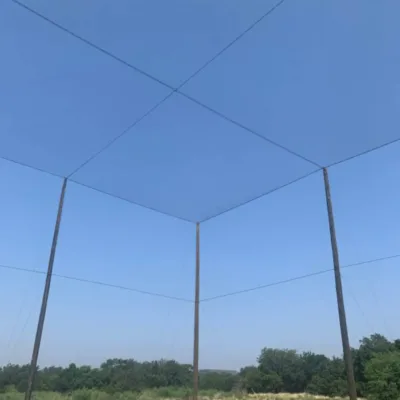
A new enclosure enables advanced drone research and testing at UTSA, according to an article by Dronelife.com.
Standing on the campus of the University of Texas at San Antonio a 900,000-cubic-foot enclosure composed of telephone poles and wire netting provides university researchers and drone enthusiasts a chance to test out and fly their aircraft without having to comply with FAA regulations.
The enclosure, which measures 150 feet by 100 feet by 60 feet tall, provides enough space to operate UAV’s in real-world, outdoor conditions without the operator having to first obtain a Part 107 license, said Christopher Combs, Ph.D., director of UTSA’ aerospace engineering program.
“The best analogy is a baseball batting cage,” Combs, an associate professor of mechanical engineering, said.
He said because the testing facility is enclosed, and is therefore not a part of the FAA-regulated airspace, it allows faculty members who use drones as part of their research, but who are not necessarily registered drone pilots themselves, the opportunity to fly.
“We have researchers doing all kinds of stuff, anything where you really need a large space to fly a drone,” Combs said. “You can only do so much in a lab space.”
In one example of the use of the enclosure, civil and environmental engineering researchers employed drone and artificial intelligence technology to study ways to put UAVs to work in intelligent construction management and surveying. “If you can imagine it, instead of having to survey a bridge or a big beam of a highway overpass that’s under construction, you can fly a drone over it and then use AI or machine learning to interpret those images,” Combs said.
He said he has also employed the outdoor testing facility himself in his own research in the field of aerodynamics.
“I do fluid physics and fluid visualization, and so we’re talking about taking some of our cameras and our measurement techniques out there to go and actually watch some drones in free flight and measure the air flow around the drones,” he said. “So, we needed a big enough space to where we could actually do that.”
The enclosure, which began operations in June 2023, was built at a cost of about $150,000 in university strategic investment funds. Combs said he believes it is the third largest facility of its type in the country and one of the largest to have been funded and built by a university.
Combs is also the director of the UTSA’s Center for Advanced Measurements in Extreme Environments. The mission of CAMMEE, which started as a NASA-funded center, focuses on building a sustainable source of diverse, highly trained researchers to enter the nation’s workforce in the fields of earth system sciences, remote-sensing technologies, computational fluid dynamics and experimental fluid mechanics.
He said the construction of the outdoor drone training enclosure is part of a larger effort to recruit and train the next generation of aerospace professionals.
Soaring to new heights, together.
Be sure to visit the BWU Technology Partnerships Initiative website to learn more about how our NEOFIX program drives economic growth, promotes policy and infrastructure to improve drone safety and efficiency in various industries, and ensures that drone technology is being used responsibly.

